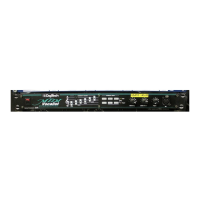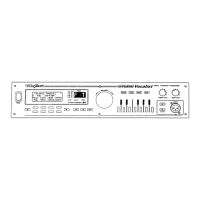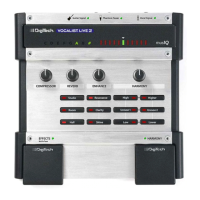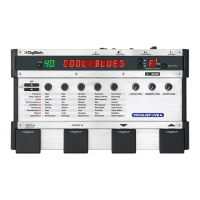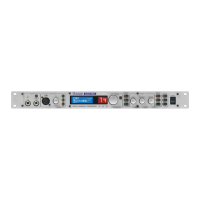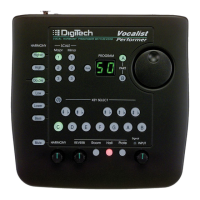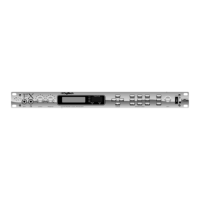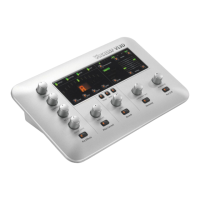
Do you have a question about the DigiTech VOCALIST VL3D and is the answer not in the manual?
| Brand | DigiTech |
|---|---|
| Model | VOCALIST VL3D |
| Category | Computer Hardware |
| Language | English |
Warnings regarding electric shock, fire hazards, and proper handling of the equipment.
Guidelines for preventing damage from liquids, storms, and ensuring proper ventilation and servicing.
Describes the VL3D as an intelligent vocal harmony processor with studio-quality audio and easy control.
Explains musIQ as a revolutionary technology for automatic, musically correct vocal harmonies based on MIDI or guitar input.
Details the items that should be included with the Vocalist VL3D, such as the unit, power adapter, and manuals.
Advises on the correct sequence for powering up amplifiers and the VL3D to prevent damage.
Details controls for Warmth, Compressor, De Esser, Noise Gate, and Pitch Correction.
Explains Reverb types/level and the front panel LEDs/display for signal status and tuning.
Covers the Mode button, Musical Indicators, and controls for managing Harmony Patches and A/B parts.
Details controls for Harmony Mode, Gender, Voicing, Mix, Humanize, On/Off, and Part A/B selection.
Explains the Power Input, USB MIDI, MIDI In, and MIDI Thru connections for power and data transfer.
Describes the Headphone Output and Guitar Thru jack for audio monitoring and signal routing.
Details the Guitar In, Line In, Mic In, Mic/Line Input Level, and 48V phantom power switch.
Explains the Ground Lift Switch and the Footswitch jack for system noise reduction and external control.
Explains how to connect a keyboard's MIDI output to the VL3D's MIDI In for harmony generation.
Details how to enter the MIDI Configuration Menu and set the desired MIDI channel for keyboard input.
Explains how to route the guitar signal through the Guitar In and Guitar Thru jacks for musIQ analysis.
Instructs users to select the musIQ Guitar mode using the Mode button for guitar-based harmonies.
Guides on setting Guitar Sensitivity (Hi/Lo) based on the Guitar Signal Strength indicator.
Instructions on activating and using the VL3D's built-in tuner for guitar strings.
Details using the VL3D's USB port as a direct MIDI interface for data transfer to/from a computer.
Describes connecting the VL3D to a computer through an existing separate MIDI interface.
Explains the Warmth control for tube preamp emulation and the Compressor for dynamic range control.
Describes the De Esser for sibilance reduction and the Noise Gate for background noise muting.
Provides instructions on storing changes to a selected Harmony Patch and recalling saved patches.
Details how to select between Part A and Part B for harmony presets and the need for individual saving.
Explains how musIQ technology automatically generates harmonies based on MIDI or guitar input.
Details the Acappella mode for vocalists without instruments, requiring manual Key and Scale settings.
Explains how to set the MIDI channel for the VL3D to receive MIDI messages, including 'AL' for all channels.
Details how to set a Split Point to define active and inactive zones for MIDI note processing.
Describes the two modes for controlling harmony voices in MIDI Notes mode: single channel or four separate channels.
Details how to set the MIDI channel specifically for receiving Control Change (CC) messages.
Details the VL3D's ability to accept Program Change messages for harmony patch selection.
Lists the global parameters that are automatically saved when changed, such as Guitar Sensitivity and MIDI settings.
Details the 10 Program Change messages and their corresponding Harmony Patch and Part selections.
States that the VL3D does not support parameter edits via SysEx, as all parameters are MIDI CC controllable.
Details CC messages for controlling Pre-Effects, Reverb, Harmony Mix, Humanize, Voicing, and Gender.
Details CC messages for controlling Harmony Mode, Acappella Key, and Acappella Scale.
Details specifications for Mic Preamp, Line Inputs, Guitar/Thru, Outputs, Headphone, and Digital Connections.
Lists power requirements, product dimensions, and the overall weight of the VL3D unit.


